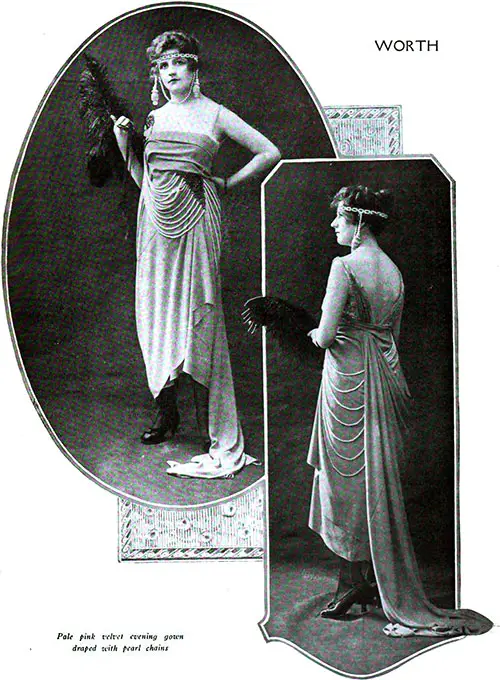House of Worth - Parisian Fashion Design Firm - 1920

Pale pink velvet evening gown draped with pearl chains
Black, Blue or Brown, Combined with Bright Colors, Distinguish Day Dresses, Ravishing Evening Gowns Sustain Reputation of This House
The house of Worth, which has dressed queens for half a century, still keeps from father to son its reputation of unrivaled elegance.
The style at Worth's is most varied, while he keeps up his reputation for dazzling evening gowns.
The regulation coat-dress of serge or duvetyn has a high collar but opens in a narrow slit almost to the waist. Other day dresses, rather tightly fashioned, have boléro-bodices that is the blouse is detached at the front like a short coatee; a brown duvetyn with one of these Zouave jackets opens over a high necked waistcoat of nasturtium silk.
Black over black or a bright color, dark blues and browns in kashavella (a delightfully soft, light stuff), velours and satin cloth are patronized. A smart idea appears to be lozenges of bright blue brocade regularly inlet with black stitching on blue serge worn with a tiny vest of the brocade.
The straight line is interpreted under its every form: pointed side panels hanging below the hem, flat aprons, irregular tunics slanting up the front to one side, dresses, all loops of different lengths, pleasantly vary the most rational of fashions—that where the lines of the figure are followed without exaggeration.
The long coat-tunic even worn over a different front is smart; a good model is a yellow and blue plaid worn over a plain navy blue front buttoned tightly from neck to hem in yellow. I saw several wooden bead belts, an ivory and onyx one suspends an apron front.
Sleeves are long, tight or flaring according to the material. Big lace puffs coming out of wide cuffs are very eighteenth century. A blue serge dress has three-quarter sleeves ending in broad frills of bright blue grosgrain ribbon sewn on in narrow loops.
Among the novelties in trimmings we find white crochet braid studded with steel, velvet appliquéd designs on silver, straight dresses almost wholly in beautiful, blurry woolen chain stitch. A blue serge gown has an original skirt of alternate diagonal strips of black waxed satin and the serge.
Worth's afternoon gowns show the lowered waistline and slightly longer skirts. The silhouette is a little ampler, chiefly because many of the more elaborate frocks are made of chiffon, Georgette or lace over silk, the favorite color being black.
Black lace draped over black taffeta; black satin, beaded, with a net and ribbon tunic at the back, are very elegant and dignified. A touch of color is given on a black crepe de Chine by a nasturtium sash, and another black chiffon model has long points, of yellow silk muslin mixed in with the black.
A cloth of silver gown reverses the classical order of things by being worn over, instead of under, a black velvet sheath.
Evening dresses are chiefly draped velvet, brocades and lamés; the somewhat longer than usual skirt ending in a train, Worth believing, like most great designers, in the long unbroken enveloping line.
Silver and gold cloth shot with pink, mauve, beige, emerald, and pale greens, crepes de Chine, jade, daffodil, cherry and white, much silver lace, are the leading materials.
Décolletés are low but beautifully draped without any suggestion of bareness; jeweled straps, belts, and strings of pearls and stones keep the draperies in place or appear to.
I noticed a good many flowers, bunches or wreaths, a good way of beginning or ending a skirt. A wreath of white camellias look well over the shoulder of a grey brocade, so does black lace and water lilies.
A gold lamé dress, tightly swathed, has a train starting from the side under a beautiful garland of golden and purple grapes.
A favorite way of draping is to wind the precious material around the body with a slightly upward movement and then allow the free end to trail on the ground. Another manner is to let the end of a wide sash form the train.
A third device is to shorten the end of the drapery into a loop and have a distinct train coming from the waist. A white crepe de Chine is most effective built along these lines with a loose network of pearls for shoulders and sleeves.
Pale pink muslin tunics, superposed and pointed, also end in trains. In the case of a severe black velvet, the bodice is four points connected by jeweled straps; the skirt ends in a train; so far there is nothing remarkable but this gown is worn with a jade green crepe turban, one loose end of which descends down the back blending with the first narrow little fishtail.
To finish on a totally different note, a low round necked white Georgette “chemise” with black tulle wings is striped from neck to hem by long strings of jet caught in at the waist by a most elaborate belt of diamonds.
A very strong collection of evening coats, principally velvet and brocade, often blended together, very ample and magnificent for our skimpy times, accompany these beautiful gowns.
"Worth" in the Garment Manufacturers’ Index, New York: The Allen-Nugent Co. Publishers, Vol. II, No. 3, October 1920: 22.
Note: The House of Worth was founded in 1858 by designer Charles Frederick Worth Upon Worth's death in 1895, sons Gaston-Lucien (1853–1924) and Jean-Philippe (1856–1926) assumed the business and were operating the House of Worth when this article was written.
